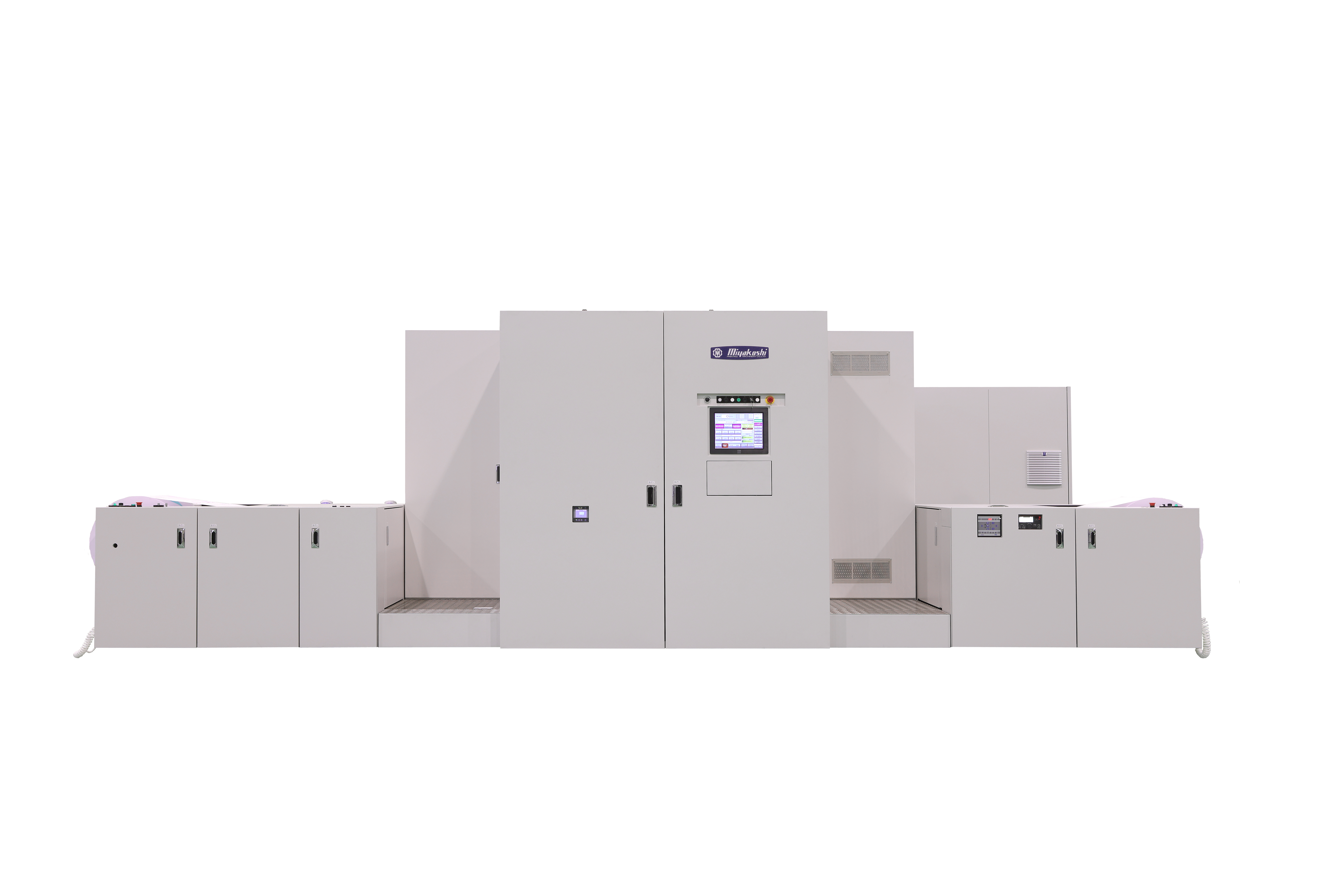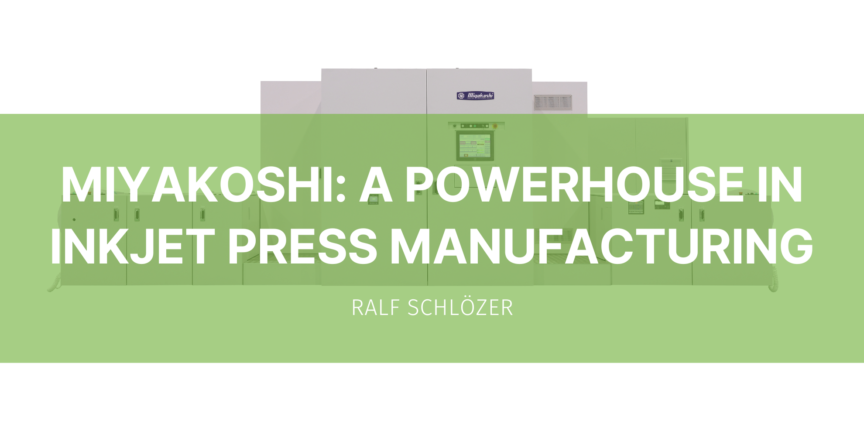Some in the printing industry might be quite familiar with Miyakoshi, while others probably have never heard the name. It is an interesting case of an influential supplier to the inkjet printing industry although many might not have seen the company name on a press. With a focus on manufacturing devices for other companies, Miyakoshi equipment is behind more presses than many realise.
A heritage in precision web handling
Miyakoshi was founded in 1946 as ironworks and started producing printing presses early on. After some business takeovers and reorganizations, the company has now several offices and production sites in Japan.
Traditionally Miyakoshi is steeped in manufacturing narrow web offset presses, as used for forms or label printing. The company is still very active selling those and is moving into flexo printing technology as well. Additionally, the company manufactures web finishing, rewinder, and unwinder equipment. The heritage in precision web press manufacturing helped the company to expand into other print technologies.
Miyakoshi moved into digital printing first when providing web transport for Kodak Versamark (or Scitex at that time) heads in the early 2000s. In a second stage of inkjet involvement in 2008, the company tied up with Kyocera, using their inkjet heads to develop and manufacture web-fed production inkjet presses. Those presses were mostly sold under OEM agreements by Canon and Fuji Xerox (now Fujifilm Business innovation), although Miyakoshi sold the same hardware under its own label into Japan and some East Asian countries. Other inkjet and liquid toner models were sold exclusively under the Miyakoshi brand.
The portfolio today
Naturally, the digital printing press portfolio developed over time. In the digital arena, Miyakoshi has a range of inkjet presses available. All presses are named as a combination of numbers of letters, which makes distinguishing them sometimes a bit challenging.
Well established are the MJP IXS and IXW series, which comes in two widths, with 508 mm or 750 mm. A resolution of 1,200 x 1,200 is possible and speeds up to 80 m/min. The two-tower duplex presses use water-based inks, can print on uncoated and coated papers, targeted magazines, transaction, direct mail, books and brochures.
With the MJP20E a single tower 2-up press is on offer as well. In addition to process colours, two additional colour channels can be added. With the max resolution of 600 x 600 dpi a speed of 100 m/min can be achieved. The press is targeted at document, direct mail, book, manual and calendar printing.
The latest addition to the inkjet portfolio is the MJP20EXG. It is a 20” (2-up) full colour inkjet press with a max resolution of 1,200 x 1,200 dpi. The full speed of 160 m/min (525 ft/min) is reached at half the resolution. Papers in the range of 64 to 157 gsm can be used. The press comes with water-based pigment ink and a Miyakoshi controller.
While the base specs are not especially intriguing, the uniqueness of the press is its compact footprint, simple design and affordability. Including unwind and rewind the press is just 8m long (26 ft), which is very small considering the productivity. This comes at a price as the drum drier means that only uncoated papers can be used. Accordingly, the press is targeting book and data printing. With a small footprint and a low price of the press especially distributed book printing could be an opportunity for the 20EXG. It could also be a solution for swapping old printers in companies with limited space.
Available as 4/4 colour press, a mono version is offered as well. The first public appearance of the MJP20EXG will be at IGAS 2022, taking place in November. Two early presses are already in production in Japan.

MJP20EXG – single tower inkjet press
Miyakoshi is not only active in document printing, the company has started to move into label and packaging printing. As first inkjet label press, the MJP13LXV was launched in 2019. With a 1,200 x 1,200 dpi resolution and a speed of up to 50 m/min, using LED UV inks the press plays in a range where many label inkjet presses are offered today.
More recently the MJP30AXF has been added for flexible packaging printing. It also available from Fujifilm as FP790. The flexible packaging market is a largely untapped market for inkjet so far. Unlike its predecessor, the MJP30AXF is using aqueous inkjet, which most brand owners around the globe strongly prefer. Launched in 2020 a first installation took place at a leading Japanese flexible packaging printer this year. So far Kanaoka Packaging used conventional presses only, but now built a new site to focus on digital printing. There is space to add several more lines. The MJP30AXF has a print width of 750mm and is capable of running at 50 m/min (164 ft/min). The press uses 1,200 dpi heads from Kyocera for CMYK and double hit white printing.
Focusing on growth
As a mid-size company with 568 employees in the group, Miyakoshi naturally has to focus on some segments and markets.
Miyakoshi is seeing the future in inkjet technology. Developments in liquid toner, which some previous presses used, have been halted. In analogue printing Miyakoshi is moving into flexo, where good growth is expected as well. The range of post press equipment is also being expanded to cater for a more efficient processing of short runs.
While offering a wide range of analog and digital presses, Miyakoshi is somewhat restricted in the geographic sales network. The main focus is on Japan, with additional sales into China and other Southeast Asian countries for inkjet presses. The company has a sales subsidiary in Spain to cover the European market, however only for narrow web analog presses. Other regions are covered by the OEM-partners, selling the machines under their respective brand names. It is likely that Miyakoshi will continue with the OEM-partner model, but sales under the Miyakoshi brand should be increasing as well, either direct or via channel partners. The success of the European subsidiary in Spain, a joint venture with a local company established in 2015, should be encouraging.
The recent launches confirm that Miyakoshi is a hotbed of digital press innovation. With the company moving into digital label and packaging printing and leveraging its expertise in finishing lines we should see more interesting products in the future.

